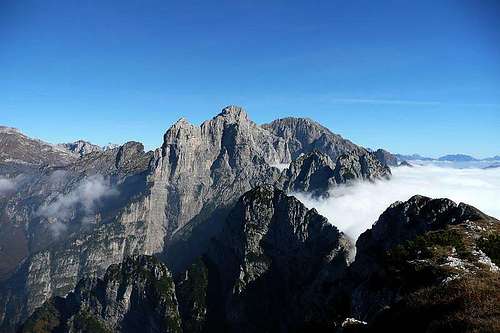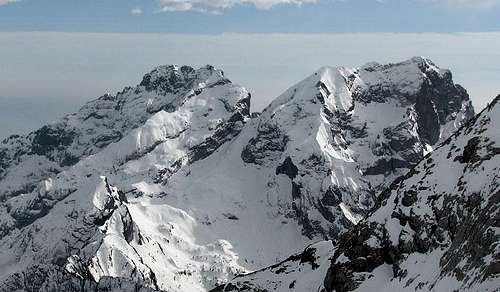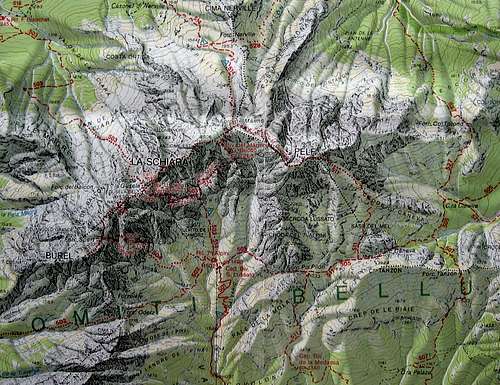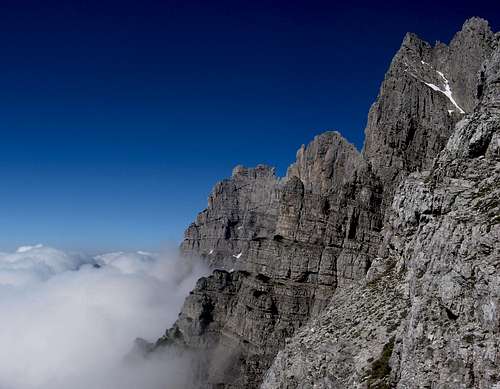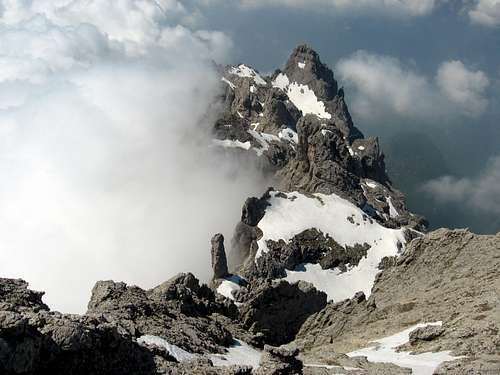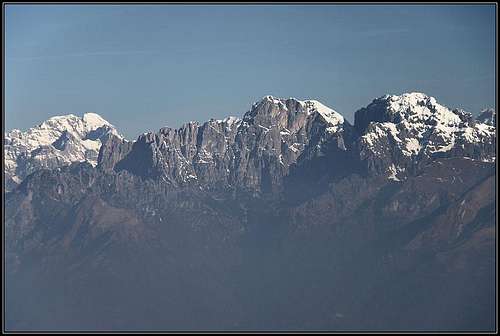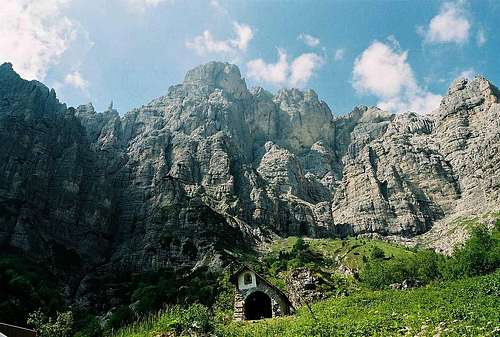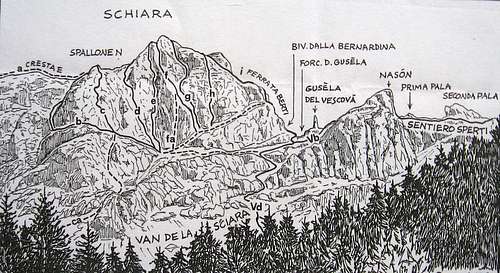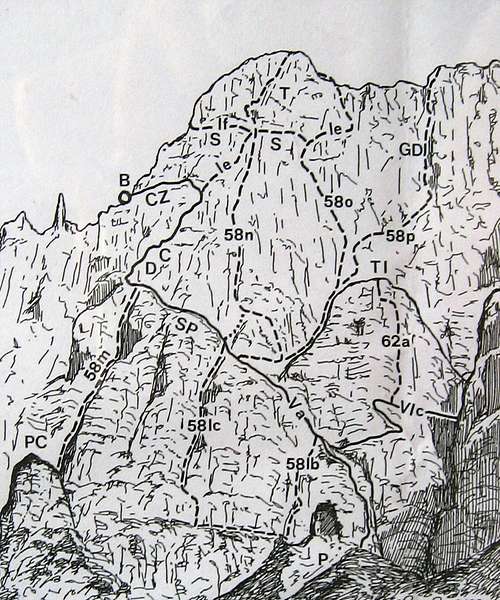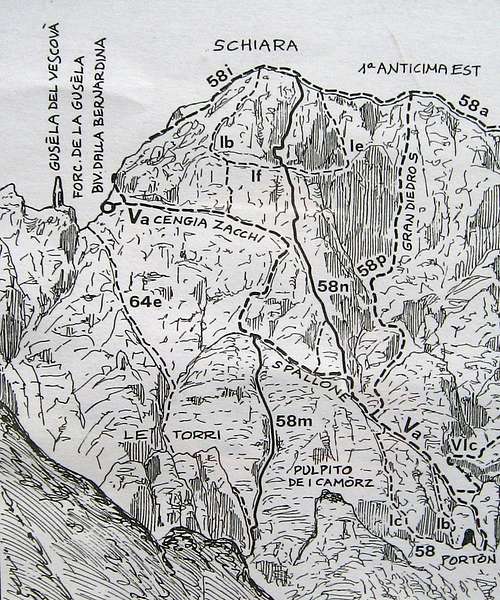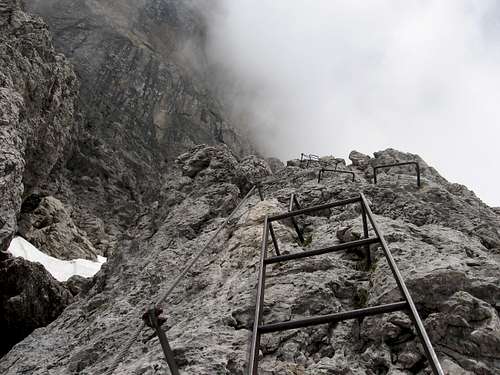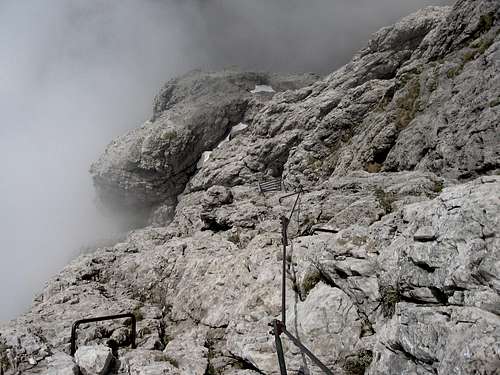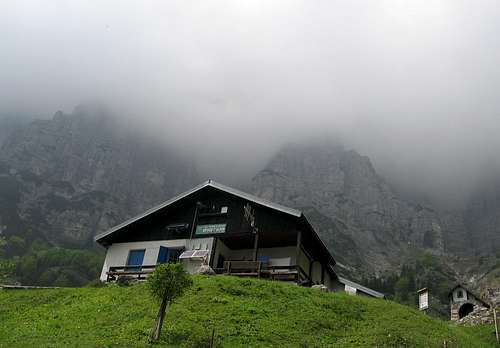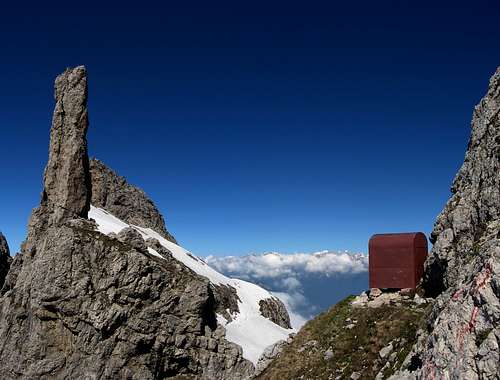-
 21821 Hits
21821 Hits
-
 92.59% Score
92.59% Score
-
 39 Votes
39 Votes
|
|
Area/Range |
|---|---|
|
|
46.23258°N / 12.18281°E |
|
|
Hiking, Mountaineering, Trad Climbing, Scrambling, Via Ferrata |
|
|
Spring, Summer, Fall |
|
|
8415 ft / 2565 m |
|
|
Overview
Schiara Group
What's New on this Page?
* Jul 28, 2017 - Ownership switched by andrea
* Jul 31, 2017 - Page under review
* Mar 17, 2018 - Overhaul of the page
The Schiara massif is a wide group located amongst the "Valle del Piave", the "Canale d’Agordo" and the "Valle di Zoldo". It is also part of the "Parco delle Dolomiti Bellunesi" and situated in its East sector. "La Schiara", also called in the local dialect "S'ciara", it's a Dolomite peak overlooking the town of Belluno for more than 2000 meters drop in altitude, and the major elevation of the entire group. It is also a group by itself.
The structure of the mountain encloses two other summits and several minor peaks. "Schiara" 2565 m, "Burel" 2281 m and together with the "Pelf" 2502 m, look if seen from south, like a giant rocky wall about 800 meters high from the base. If seen from far, they seem a compact wall; but unlikely they have several series of caves, pillars and secondary ridges.
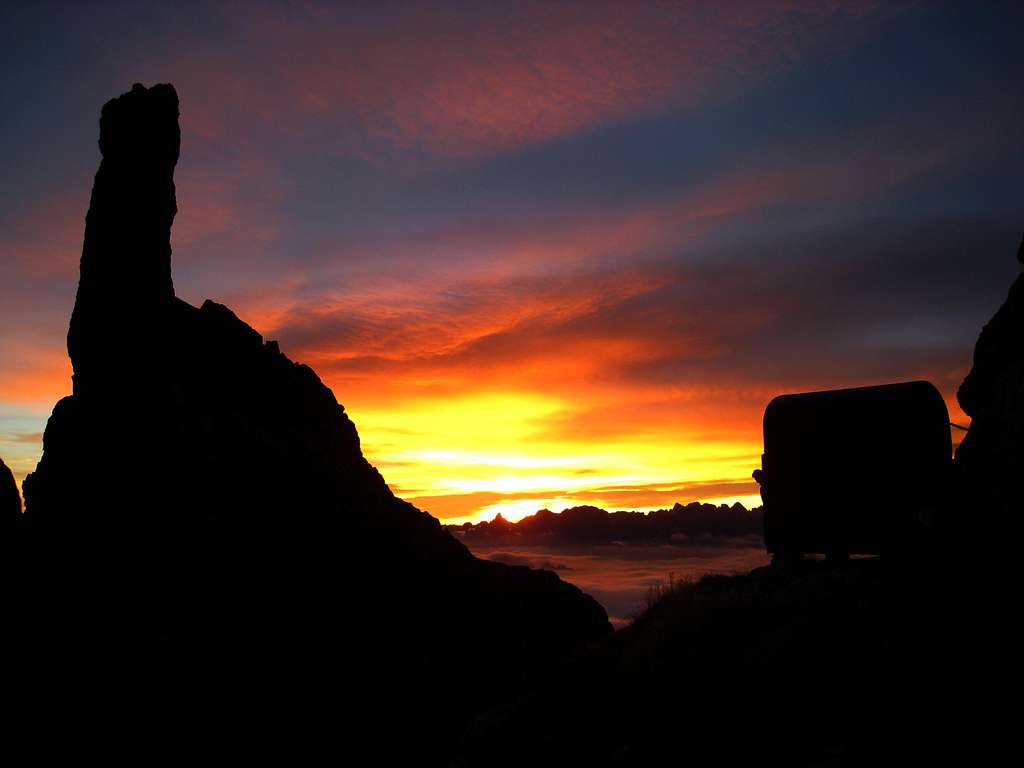
Besides the main chain Schiara-Pelf, with the Dorsale del Pelf, Dorsale della Schiara and Dorsale del Coro, the massif has two other main sub-groups counting several small groups that should have specific classifications, difficult to list in the same page. Amongst them, the most important are: the chain Talvena-Zità, with the complex Cime de Zità-Bachet and the Talvena Massif, and the chain Tiron-Pala Alta-Serva with the Dorsale del Tiron, Dorsale della Pala Alta and Dorsale di Serva. In this page will be listed only the characteristics of the main Schiara group enclosed between the "Forcella Nerville" and the "Canale d'Agordo". The southern side is bordered on east by the Forcella Marmol (2262m) and on west by the Forcella Sperti (2331m). At the base of the main wall, a particular cave is called "Porton". East part of Monte Schiara, the Pelf 2502 m has the characteristic round shape, but less climbing interests. The Burel and the west side of the massif 2281m are not very high but with an impressive south face above the Canale d’Agordo (numerous climb routes on this wall). On the South side four “via ferrata” has been created and they allow interesting approaches to the mountain. Those are the Vie Ferrate: "Sperti", "Zacchi","Marmol" and "Berti" leading to the main peak. On different key positions, were also set up three useful bivouacs: "Biv Sperti" (2000m), "Biv. Bernardina" (2320m) and "Biv. Bocco" (2266m). A useful starting point for many trips is the refuge "7° Alpini" (1500 m) reachable from the hamlet "Case Bortot" above Belluno (path 501.) in 3 hours.
Subgroups that belongs to Schiara massif
Monte Talvena 2542m Cime de Zità 2465m 2451m 2450m Cime del Bachèt 2284m 2342m 2297m 2241m Zest del Vescovà 2379m
Cime della Scala 1902m
Pelf (2502 m); Cime di Caiàda 1850m Cimòn 1819m
Cima del Burel 2281m
Monte Zelo 2083m
Monte Coro 1985m Pale Magre 2136m Spirlònga 1600m
Catena del Terne-Tiròn-Sabiòi Monte Terne 1794m Tiròn 2000m Cima dei Sabiòi 1997m Pale dei Pinèi 1995m 1964m 1890m
Catena della Pala Alta Pala Alta 1933m Pala Bassa 1862m
Monte Serva 2133m
Other minor peaks of the main Schiara massif
TORRIONE FRANCESCO AGNOLI 2209m It is the massive tower, visible from the refuge 7° Alpini, which forms the eastern corner pillar on the south wall of the Schiara; and with the Pelf, the entrance to the south couloirs of Marmol.
CAMPANILE ALVISE ANDRICH It’s the one on the right of the two towers that rise at the foot of the south wall of Schiara; between the Porton and the Torre Agnoli. It is shaped like a spire, with a south wall and two lateral ridges.
TORRIONE “ALDO COMUNELLO” It's the bold tower separate from the Porton by a deep gorge located immediately on the left of the Campanile Andrich.
TORRIONE IVANA 2150m
PULPITO DEI CAMORZ 1848m It's the visible cylindrical spike that extends at the foot of the south wall of Schiara.
GUSELA DEI VESCOVA’ 2365m Small but very sharp spire, visible from Belluno. Despite high only 40 meters, it is impressive for the purity of the line and the isolation on the ridge.
1st 2nd 3rd 4th 5th PALE DEL BALCON Rocky ridge with numerous peaks, enclosed between the Gusela del Vescovà and the Burel.
IL NASON 2385m It's the highest elevation of the Pale Balcon. Very characteristic shape like a big nose that gives it its name.
LE TORRI Group of small towers on the south side of the mountain: Torre Treviso 2000m Torre Renata 2000m Torre Anna Torre Franco Naldini Torre Giovanna 2150m
Routes overview of the main Schiara massif
East ridge: the old normal route. from "forcella Marmol". Not recommended. Nowadays the more modern ferrate are preferred.
North flank: Very long approach. The north side of the mountain is very impressive but with a little climb interest. From I° to III° with a passage of IV° below the summit. Troublesome.
Northwest ridge: From biv.Bernardina. Funny and nice climb. 400m II°/III°.
Northwest wall (left side): From biv.Bernardina. Bad rocks. 400m IV°/V°.
Nortwest wall (via dei Polacchi): From biv.Bernardina. Very interesting. 400m VI°/A2
West wall: From biv.Bernardina. Nice and classic route. 400m III°/IV°.
South wall (via Zacchi-Olivotto): From the base of the wall. 800m II°/III° with a passage of IV°.
South wall (via Sperti-Viel): From the base of the wall. Same difficulties than Zacchi-Olivotto but more advisable.
South couloir (via diretta): From the base of the wall. 800m IV°/V°.
South pillar (via diretta): First part in common with "ferrata Zacchi". 550m IV°/V° A2.
Grande Diedro del Burel: 1500 m of difference in elevation, in Dolomites the 2nd for height after the Agner N spur. Bebak, Ferenski, Zawadzki (polish) + Garna and Gianeselli were the first climbers in 1974 then some more routes were opened
Vie Ferrate
- Via Ferrata Zacchi - Via Ferrata Zacchi leads from the "Porton"(1780m), about 25 minutes from the refuge "7° Alpini" 1502 m to the bivouac "Ugo Dalla Bernardina" 2320 m, not far from the Gusela del Vescovà, along the south face of Monte Schiara. It is considered one of the most beautiful and difficult Via Ferrata in the Dolomites, although the large number of steps which limits a bit the charm. The ferrata rises vertically alternating pieces almost always unshod (presence of many chimneys), and spare no path equipped, while the last step leading to the camp in the horizontal direction along the ledge "Zacchi". The travel time of the via ferrata is about 2:30 to 3:00 hours. The ascent to the summit of Monte Schiara is possible across the Via Ferrata Berti, about an hour.
- Via Ferrata Berti - Built in 1959, it represents the continuation of the Via ferrata Zacchi, in fact it starts from the bivouac Ugo Dalla Bernardina 2320 m, reaching the summit of the mountainat 2565 meters in about a 1 hour. The ferrata, equipped with wire ropes and ladders, it is quite difficult even if it requires the same attention.
- Via Ferrata Marmòl - It was completed in 1967, but it has recently been re-equipped. It goes along the cliffs to the south-east of Monte Schiara. Along the ferrata track uphill, make the first 100 meters in common with the Via ferrata Zacchi. The ferrata can be reached in around 3:30, about 2262 meters, passing the bivouac Bocco. Usually, however, given its modest difficulty, the ferrata is crossed downwards, as a continuation of the Via ferrata Zacchi and Via Ferrata Berti to descend from the summit. The iron ropes can also be used to reach the summit of Monte Pelf (forcella Marmol must walk the path equipped Marino Guardian).
- Via Ferrata Sperti - From the refuge 7°Alpini take the path 504 leading to the attack of the Via ferrata (1800 meters. About; 0:45 from the refuge). This ferrata offers many interesting passages and glimpses of rare beauty, but should be approached with caution (long stretches without equipment). Reached until the Bivouac Sperti 2100 m, then climb up a gully and a steep wall to Forcella Sperti". Then goes on to ledges, and continues up and down untill the bivouac "U. Dalla Bernardina".
- Via Ferrata Berti - Built in 1959, it represents the continuation of the Via ferrata Zacchi, in fact it starts from the bivouac Ugo Dalla Bernardina 2320 m, reaching the summit of the mountainat 2565 meters in about a 1 hour. The ferrata, equipped with wire ropes and ladders, it is quite difficult even if it requires the same attention.
- Via Ferrata Marmòl - It was completed in 1967, but it has recently been re-equipped. It goes along the cliffs to the south-east of Monte Schiara. Along the ferrata track uphill, make the first 100 meters in common with the Via ferrata Zacchi. The ferrata can be reached in around 3:30, about 2262 meters, passing the bivouac Bocco. Usually, however, given its modest difficulty, the ferrata is crossed downwards, as a continuation of the Via ferrata Zacchi and Via Ferrata Berti to descend from the summit. The iron ropes can also be used to reach the summit of Monte Pelf (forcella Marmol must walk the path equipped Marino Guardian).
- Via Ferrata Sperti - From the refuge 7°Alpini take the path 504 leading to the attack of the Via ferrata (1800 meters. About; 0:45 from the refuge). This ferrata offers many interesting passages and glimpses of rare beauty, but should be approached with caution (long stretches without equipment). Reached until the Bivouac Sperti 2100 m, then climb up a gully and a steep wall to Forcella Sperti". Then goes on to ledges, and continues up and down untill the bivouac "U. Dalla Bernardina".
Red Tape
No fees no permits required. The whole group is part of the Dolomiti Bellunesi, a mountain system included among the nine ones acknowledged as an UNESCO World Heritage Site in 2009. More info about Dolomiti Unesco World Heritage here:
- in the article by Silvia Mazzani: Dolomites living mountains
- on the Unesco Official web-site: Unesco
- on the Fondazione Dolomiti Unesco web-site: Fondazione Dolomiti Unesco
Huts and Bivouacs
Rifugio VII Alpini: 1500m Places 60+9 From "Case Bertot" 3.00h E
Rifugio Fulvio Bianchet: 1250m Places 40+6 From Pinei 2.30h T
Bivacco Sperti: 2000m Places 6 From ref. 7°Alpini 2hours EE
Bivacco Ugo della Bernardina: 2320m Places 6 From ref. 7°Alpini 2.30hours EEA
Bivacco Marmòl: 2266m Places 9 From ref. 7°Alpini 2hours EEA
Bivacco Medassa: 1340m Places 8 From "Case Bortot" 2h E
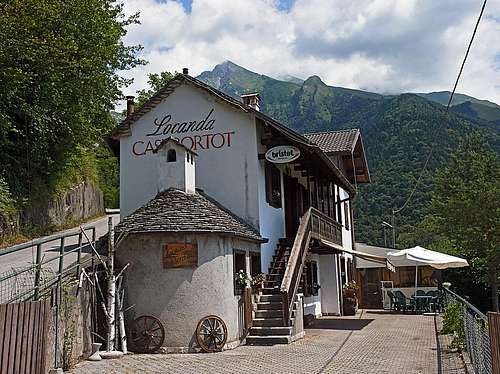
When to climb
Best season is from June to October.


